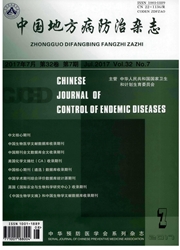

 中文摘要:
中文摘要:
目的通过饮食控制碘铁摄人量,建立典型碘铁联合缺乏的大鼠动物模型。方法断乳sD雄性大鼠按体重随机分为对照组和模型组,每组30只.分别饲以正常和缺碘缺铁饲料,饮用去离子水。饲养6周后,测量体重和观察发育状态;处死后摘取甲状腺组织称重。过硫酸铵消化砷铈催化分光光度法测定大鼠尿碘,化学发光法测定血清甲状腺激素水平,生化方法测定血红蛋白浓度,血清铁,总铁结合力。其余大鼠12周后进行同样处理。结果饲养6周后模型组大鼠皮肤较对照组苍白,皮毛粗糙稀疏,体重减轻,甲状腺重量明显增加,尿碘水平(22.5μg/L)较对照组(163.8μg/L)明显降低,与碘摄入量基本平行,血红蛋白浓度和血清铁[(69.2±7.4)g/L,(4.9±1.4)umol/L]较对照组[(161.1±9.4)g/L,(27.3±6.5)μmol/L]降低,总铁结合力[(176.3±4.4)μmol/L]较对照组[(99.1±9.0)ixmol/L]增加,游离T4,反T3[(19.45±1.97)pmol/L,(0.20±0.03)nmol/L]较对照组[(34.01±3.28)pmol/L,(0.32±0.06)nmoL/L]降低,模型组大鼠TSH亦有明显增高[(3.11±1.52)VS(1.96±0.83)mU/L],两组问比较差异均有统计学意义(P〈0.05)。饲养12周后,大鼠各项检测指标数据与6周时相似。结论此模型同时具有明显碘缺乏和铁缺乏特征。通过饮食控制大鼠碘铁摄入量可以成功制备典型的碘铁联合缺乏大鼠动物模型。
 英文摘要:
英文摘要:
Objective To establish a representative rat model with combined iodine deficiency and iron deficiency by controlling the dietmy iodine and iron. Method Weaning SD male rats were randomly divided into control group and model group by body weight, and 30 in each group were fed with normal feedstuff and reformative feedstuff ( devoiding iodine and iron) respectively, drinking deionized water. After 6 weeks, body weight was scaled, development state was observed, and thyroid glands were re- moved and weighed after execution. Urine iodine was measured by As3 + - Ce4 + catalytic spectrophotometry using ammonium persulfate digestion; thyroid bormone levels in serum was detemlined by chemiluminascent assay; hemoglobin concentration, ser- um iron and total iron binding capacity(TIBC) were measured by biochemical assay. After 12 weeks, the rest rats were treated as the former. Result After 6 weeks, compared with the control group, rats in model group showed pale skin, sparse rough fur, and body weight loss. But the weight of thyroid glands in model group increased significantly( P 〈 0.05), and the urine iodine (22.5μg/L) was lower than the control group( 163.8 μg/L), which was parallel with the intake of iodine. In model group, he- moglobin concentration and serum iron concentration[ (69.2 ± 7.4) g/L, (4.9 ± 1.4) μmol/L] were less than that in control group [ ( 161.1 ± 9.4) g/L, (27.3 ± 6.5) μmol/L], TIBC[ ( 176.3 ±4.4) p,mol/L] was more than that in control group[ (99.1 ±9.0) μmol/L]. The free T4 and reverse T31 ( 19.45 ±1.97), (0.20 ± 0.03) pmol/L] was less than that of control group[ ( 34.01 ± 3. 28), (0.32± 0.06) pmoL/L], and TSH of the rats in model group rose obviously[ ( 3.11 ± 1.52) vs ( 1.96 ± 0.83) mU/L]. The differences between two groups were statistically significant ( P 〈0.05). After 12 weeks, the similar results were showed. Con- clusion This model has the typical characteristics of both iodine deficiency and iro
 同期刊论文项目
同期刊论文项目
 同项目期刊论文
同项目期刊论文
 期刊信息
期刊信息
